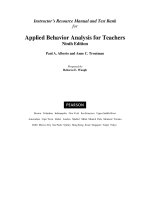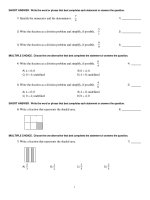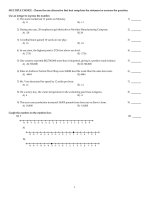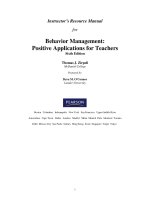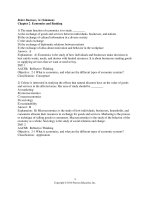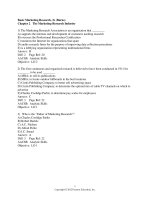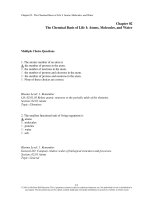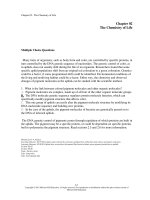Competing for advantage 3rd edition hoskisson test bank
Bạn đang xem bản rút gọn của tài liệu. Xem và tải ngay bản đầy đủ của tài liệu tại đây (181.29 KB, 15 trang )
Chapter 2 - Strategic Leadership
TRUE/FALSE
1. Different approaches to leadership by CEOs such as Jack Welch and Sam Walton demonstrate the
profound influence strategic leaders can have on an organization.
ANS: T
OBJ: 1
PTS: 1
NOT: application
DIF: med
REF: p. 34
2. Strategic leadership is the ability to anticipate, envision, maintain flexibility, and empower others to
create strategic change as necessary.
ANS: T
OBJ: 1
PTS: 1
NOT: knowledge
DIF: med
REF: p. 35
3. Strategic leadership entails the set of assumptions, premises, and accepted wisdom that bounds or
frames a manager’s understanding of the firm.
ANS: F
OBJ: 1
PTS: 1
NOT: knowledge
DIF: med
REF: p. 35
4. Effective strategic leaders are willing to make candid, courageous, yet pragmatic, decisions—decisions
based mostly on the leader’s seasoned intuition.
ANS: F
OBJ: 2
PTS: 1
DIF: med
NOT: comprehension
REF: p. 37
5. A manager’s decision discretion is influenced by his or her own characteristics, environmental sources
external to the firm, and characteristics of the Board of Directors.
ANS: F
OBJ: 2
PTS: 1
DIF: hard
NOT: comprehension
REF: p. 37
6. Firm size, firm age, tolerance for ambiguity, and commitment to strategic outcomes are all examples
of characteristics of the organization that may affect managerial discretion.
ANS: F
OBJ: 2
PTS: 1
DIF: hard
NOT: comprehension
REF: p. 37
7. External environmental factors that may affect managerial discretion include industry structure, rate of
market growth, and degree of product differentiation.
ANS: T
OBJ: 2
PTS: 1
DIF: hard
NOT: comprehension
REF: p. 37
8. In addition to determining new strategic initiatives, top-level managers also develop the appropriate
organizational structure and reward systems of a firm.
ANS: T
OBJ: 3
PTS: 1
NOT: knowledge
DIF: med
REF: p. 40
9. The more heterogeneous and the larger the top management team, the easier it is to implement strategy
effectively.
ANS: F
OBJ: 3
PTS: 1
DIF: hard
NOT: comprehension
REF: p. 42
10. The more homogeneous a top management team, the more likely those managers will be innovative
and willing to pursue strategic change.
ANS: F
OBJ: 3
PTS: 1
DIF: med
NOT: comprehension
REF: p. 41
11. Heterogeneous top management teams are more likely to change their firm’s strategies when necessary
and to support innovation.
ANS: T
OBJ: 3
PTS: 1
DIF: med
NOT: comprehension
REF: p. 41
12. It is very uncommon for a CEO to appoint a number of outside board members.
ANS: F
OBJ: 4
PTS: 1
DIF: med
NOT: comprehension
REF: p. 42
13. The experience that results from long tenure in a firm is known to extend the breadth of an executive’s
knowledge base.
ANS: F
OBJ: 4
PTS: 1
DIF: med
NOT: comprehension
REF: p. 44
14. Selection of an insider as a new CEO indicates a firm’s desire to encourage innovation and strategic
change.
ANS: F
OBJ: 4
PTS: 1
DIF: med
NOT: comprehension
REF: p. 46
15. When a new CEO is selected from outside the firm, a change of strategy is likely, especially if the top
management team is homogenous and highly cohesive.
ANS: F
OBJ: 4
PTS: 1
DIF: hard
NOT: comprehension
REF: p. 46
16. An organization leader’s new vision must take into account the current and core competencies of the
firm.
ANS: T
OBJ: 5
PTS: 1
DIF: med
NOT: comprehension
REF: p. 50
17. Neither hiring temporary workers nor star players is sufficient for developing an effective
organizational team.
ANS: T
OBJ: 6
PTS: 1
DIF: hard
NOT: comprehensive
REF: p. 51
18. The training of future strategic leaders yields a competitive advantage for a firm, in part because
knowledge and skills are necessary for successful execution of strategy.
ANS: T
OBJ: 6
PTS: 1
DIF: med
NOT: comprehension
REF: p. 51
19. Competitive aggressiveness, proactiveness, risk aversion, innovativeness, and autonomy are the five
dimensions characterizing a firm’s entrepreneurial orientation.
ANS: F
OBJ: 6
PTS: 1
DIF: hard
NOT: comprehension
REF: p. 52
20. Corporate cultures emerge in organizations, but their development is so subtle that top managers
cannot influence their formation.
ANS: F
OBJ: 6
PTS: 1
DIF: med
NOT: comprehension
REF: p. 52
21. Money motivates, social capital inspires.
ANS: T
OBJ: 8
PTS: 1
DIF: med
NOT: comprehension
REF: p. 55
22. An emphasis on strategic controls encourages managers to focus on more short-term goals and
efficient operations.
ANS: F
OBJ: 9
PTS: 1
DIF: med
NOT: comprehension
REF: p. 58
MULTIPLE CHOICE
1. Effective strategic leadership entails the ability to articulate clear ____ and ____.
a. employee attitudes, corporate culture
b. strategic change, performance trends
c. goals, objectives
d. strategic intent, motivate followers
ANS: D
OBJ: 1
PTS: 1
DIF: hard
NOT: comprehension
REF: p. 36
2. The ability to manage ____ may be the most important skill a strategic leader must have.
a. human capital
c. responses to competitors’ actions
b. capital resources
d. investment strategies
ANS: A
OBJ: 1
PTS: 1
DIF: med
NOT: comprehension
REF: p. 50
3. Some researchers argue that a firm’s long-term competitiveness depends on the:
a. ability of managers to maintain a constant managerial frame.
b. ability of managers to challenge their managerial frames on a continual basis.
c. ability of managers to fend off change.
d. abilities of lower-level management teams.
ANS: B
PTS: 1
DIF: med
REF: p. 40
OBJ: 1
NOT: comprehension
4. Which of the following is NOT a factor that determines the amount of a manager’s decision
discretion?
a. Characteristics of the manager
b. Characteristics of the organization
c. Cohesiveness of the Board of Directors
d. External environmental sources
ANS: C
OBJ: 2
PTS: 1
DIF: med
NOT: comprehension
REF: p. 37
5. All of the following are external environmental sources that affect managerial discretion EXCEPT:
a. industry structure.
b. corporate culture.
c. market growth rate.
d. potential for product differentiation.
ANS: B
OBJ: 2
PTS: 1
NOT: knowledge
DIF: med
REF: p. 37
6. All of the following are characteristics of the organization that affect managerial discretion EXCEPT:
a. size of the company.
b. availability of resources.
c. corporate culture.
d. degree of managerial self-confidence.
ANS: D
OBJ: 2
PTS: 1
NOT: knowledge
DIF: med
REF: p. 37
7. A characteristic of the manager that may affect managerial discretion is his/her:
a. interpersonal skills.
c. tolerance for ambiguity.
b. commitment to the firm.
d. aspiration levels.
ANS: A
OBJ: 2
PTS: 1
NOT: knowledge
DIF: med
REF: p. 37
8. The larger the top management team:
a. the more difficult it is for the team to implement strategies.
b. the more likely it is that the team will be homogeneous.
c. the less innovative the team’s decisions are.
d. the higher quality the team’s decisions are.
ANS: A
OBJ: 3
PTS: 1
NOT: knowledge
DIF: med
REF: p. 42
9. A heterogeneous top management team is composed of individuals with:
a. different functional backgrounds, experience, and education.
b. similar experiences and similar education.
c. a high level of education.
d. a similar level of technical training.
ANS: A
OBJ: 3
PTS: 1
NOT: knowledge
DIF: med
REF: p. 40
10. Which of the following is NOT associated with heterogeneous top management teams?
a.
b.
c.
d.
Innovation
Identification of environmental changes
Diminished debate
Strategic change
ANS: C
OBJ: 3
PTS: 1
DIF: hard
NOT: comprehension
REF: p. 41
11. The more involved a board of directors is in shaping the firm’s strategic direction:
a. the lower is the corporation’s performance.
b. the higher is the corporation’s performance.
c. the more likely it is that the firm’s top management team is homogenous in its makeup.
d. the more difficult it becomes to make executive decisions.
ANS: B
OBJ: 3
PTS: 1
DIF: med
NOT: comprehension
REF: p. 42
12. A CEO obtains power from all of the following EXCEPT:
a. the fact that many of the outside directors are appointed by the CEO.
b. the CEO is also the chairman of the board.
c. the tenure of the top management team is shorter than that of the board.
d. the fact that inside board members report to the CEO.
ANS: C
OBJ: 4
PTS: 1
DIF: hard
NOT: comprehension
REF: p. 42
13. Which of the following is NOT related to a CEO’s having long tenure in his or her position?
a. more effective strategic control
b. greater influence on organizational decisions
c. more limited perspective
d. high level of innovation
ANS: D
OBJ: 4
PTS: 1
DIF: hard
NOT: comprehension
REF: p. 42
14. An external labor market is:
a. the opportunities for managerial positions within a firm.
b. a collection of career opportunities for managers in organizations outside of the one for
which they currently work.
c. the relationship between the CEO and its subordinates.
d. influential in the building of a homogenous top management team.
ANS: B
OBJ: 4
PTS: 1
NOT: knowledge
DIF: med
REF: p. 44
15. Which of the following is NOT a benefit to the firm using the internal labor market to select a new
CEO?
a. Internal hiring results in a higher turnover rate of existing personnel.
b. Insiders are familiar with the firm’s products.
c. Insider hiring reflects a desire for continuity.
d. Insiders are more familiar with a firm’s operating procedures.
ANS: A
OBJ: 4
PTS: 1
DIF: med
NOT: comprehension
16. A CEO’s commitment to the status quo is influenced strongly by:
REF: p. 45
a.
b.
c.
d.
educational training.
the prestige of the university from which the CEO earned his or her degree.
long tenure with one firm.
the breadth of knowledge of the top management team.
ANS: C
OBJ: 4
PTS: 1
DIF: med
NOT: comprehension
REF: p. 45
17. Which of the following is NOT likely to encourage change in a firm’s strategy?
a. A new CEO from outside the firm
b. A homogeneous top management team
c. A top management team with managers from different functional backgrounds
d. A new CEO from outside the industry
ANS: B
OBJ: 4
PTS: 1
DIF: hard
NOT: comprehension
REF: p. 45 (Figure 2.2)
18. A new CEO selected from outside the firm:
a. will successfully guide the company to higher profits.
b. has a narrower perspective of the firm and its competitive environment.
c. usually encourages innovation and strategic change.
d. will not be inclined to change the strategic direction of the firm.
ANS: C
OBJ: 4
PTS: 1
DIF: med
NOT: comprehension
REF: p. 45
19. When the top management team is homogeneous and a new CEO is selected from inside the firm, it is:
a. unlikely for the current strategy to change.
b. likely that product innovation will continue.
c. likely there will be a change in strategy.
d. unlikely the new CEO will have a long tenure.
ANS: A
OBJ: 4
PTS: 1
DIF: med
NOT: comprehension
REF: p. 45 (Figure 2.2)
20. If a firm is to have an adequate number of highly qualified managers, it must tap the following highly
qualified labor pool:
a. Former employees.
b. College interns.
c. Foreign-born but U.S.-trained applicants.
d. Women.
ANS: D
OBJ: 4
PTS: 1
NOT: knowledge
DIF: med
REF: p. 45
21. Which of the following is NOT an action of effective strategic leadership?
a. Establishing ethical practices
b. Fostering an effective corporate culture
c. Developing human capital
d. De-emphasizing core competencies
ANS: D
OBJ: 5
PTS: 1
DIF: med
NOT: comprehension
22. Determining the strategic direction for the firm refers to:
a. developing a short-term vision of the firm’s strategic intent.
REF: p. 48
b. developing a tactical strategic response.
c. developing a long-term vision of the firm’s strategic intent.
d. the top management team’s heterogeneous status.
ANS: C
OBJ: 5
PTS: 1
NOT: knowledge
DIF: med
REF: p. 54
23. It is clear that large firms:
a. develop core competencies in a single functional area when implementing strategy.
b. exploit core competencies across different organizational units when implementing
strategy.
c. have an identifiable brand name in order to create a competitive advantage during the
implementation stage.
d. make a number of acquisitions in order to develop and exploit core competencies within
the organization.
ANS: B
OBJ: 5
PTS: 1
DIF: med
NOT: comprehension
REF: p. 52
24. Human capital refers to the:
a. number of employees employed by a firm.
b. resources available to the Human Resources department.
c. number of individuals comprising the top management team.
d. knowledge and skills of the firm’s work force.
ANS: D
OBJ: 5
PTS: 1
NOT: knowledge
DIF: med
REF: p. 50
25. Much of the development of U.S. industry can be attributed to:
a. the educational level of its workforce.
b. its emphasis on innovation.
c. the effectiveness of its human capital.
d. the country’s financial markets.
ANS: C
OBJ: 6
PTS: 1
NOT: knowledge
DIF: med
REF: p. 50
26. The effective development and management of the firm’s ____ may be the primary determinant of its
sustainable competitive advantage.
a. capital base
b. human capital
c. technology
d. competitive edge
ANS: B
OBJ: 6
PTS: 1
NOT: knowledge
DIF: med
REF: p. 51
27. The process of transferring host-country or third-country national managers into the domestic market
of the multinational firm is known as:
a. expatriation.
b. repatriation.
c. inpatriation.
d. reverse patriation.
ANS: C
OBJ: 6
PTS: 1
NOT: knowledge
DIF: hard
REF: p. 51
28. Many companies are now requiring ____ for top management positions.
a. development of a successful advertising campaign
b. MBAs from prestigious schools
c. specialized knowledge in a functional area
d. global competency
ANS: D
OBJ: 6
PTS: 1
DIF: med
NOT: comprehension
REF: p. 51
29. Which of the following will lead to the probability that a manager will be a successful strategic leader?
a. Appointing many outside board members
b. Increasing the firm’s sales
c. Increased expenditures on capital equipment
d. Training and development programs
ANS: D
OBJ: 6
PTS: 1
DIF: med
NOT: comprehension
REF: p. 51
30. The benefits of training and development programs include all of the following EXCEPT:
a. establishing independent core values.
b. promoting the firm’s strategic vision.
c. providing a systematic view of the organization.
d. building knowledge and skills.
ANS: A
OBJ: 6
PTS: 1
DIF: hard
NOT: comprehension
REF: p. 51
31. Which of the following is a source of competitive advantage at General Electric?
a. The firm’s Internet strategy
b. The firm’s emphasis on technology management
c. The firm’s system of training and development of future leaders
d. The firm’s strategic orientation
ANS: C
OBJ: 6
PTS: 1
NOT: application
DIF: hard
REF: p. 51
32. To successfully implement a firm’s strategy, employees must be viewed as:
a. a cost to be minimized.
b. expendable.
c. a resource to be maximized.
d. part of the organization that must be restructured.
ANS: C
OBJ: 6
PTS: 1
DIF: med
NOT: comprehension
REF: p. 50
33. Which of the following statements is true regarding effective organizational cultures?
a. Once a corporate culture is developed, strategic leaders can focus on other activities.
b. It is not possible to develop a corporate culture into a core competency.
c. A central task of strategic leaders is to change the corporate culture on an annual basis
after analyzing the changes occurring in the competitive environment.
d. Organizational culture can be a source of competitive advantage because it influences
employee behavior and the firm’s conduct in the marketplace.
ANS: D
OBJ: 6
PTS: 1
DIF: med
NOT: comprehension
REF: p. 52
34. If a firm is a market leader, rather than a market follower, it can be characterized as being ____.
a. proactive
c. strategic
b. aggressive
d. risk-taking
ANS: A
OBJ: 6
PTS: 1
NOT: knowledge
DIF: med
REF: p. 52
35. The concept of employee autonomy is highly related to the concept of ____.
a. cohesiveness
c. charisma
b. loyalty
d. empowerment
ANS: D
OBJ: 7
PTS: 1
DIF: med
NOT: comprehension
REF: p. 52
36. Which of the following is NOT one of the five dimensions thought to characterize a firm’s
entrepreneurial orientation?
a. Autonomy
c. Risk taking
b. Reactivity
d. Innovativeness
ANS: B
OBJ: 6
PTS: 1
NOT: knowledge
DIF: hard
REF: p. 52
37. A firm that has the ability to be a market leader rather than a follower is said to be:
a. innovative.
b. a risk taker.
c. proactive.
d. competitively aggressive.
ANS: C
OBJ: 6
PTS: 1
NOT: knowledge
DIF: med
REF: p. 52
38. Competitive aggressiveness describes a firm’s:
a. tendency to engage in new ideas and creative processes.
b. tendency to allow employees to take actions free of organizational constraints.
c. ability to be a leader in the marketplace.
d. propensity to take actions that allow it to outperform rivals consistently and substantially.
ANS: D
OBJ: 6
PTS: 1
NOT: knowledge
DIF: med
REF: p. 52
39. Shaping and reinforcing a new firm culture requires all of the following EXCEPT:
a. effective communication.
b. effective performance appraisals.
c. the firing of non-performing employees.
d. an appropriate reward system.
ANS: C
OBJ: 7
PTS: 1
DIF: med
NOT: comprehension
40. One catalyst for critical changes in the organizational culture is:
a. the selection of top managers from outside the corporation.
b. change in the industry structure.
c. new competition from foreign firms.
d. decreasing industry profits.
REF: p. 52
ANS: A
OBJ: 7
PTS: 1
DIF: med
NOT: comprehension
REF: p. 53
41. The Enron scandal is a good example of ____.
a. managerial opportunism
b. failure to implement the balanced scorecard
c. poor implementation of corporate culture
d. failure to adhere to the counsel of staff attorneys
ANS: A
OBJ: 8
PTS: 1
NOT: application
DIF: med
REF: p. 56
42. When organizations are reported to engage in unethical practices:
a. poor financial controls will usually be to blame.
b. the value in the stock market tends to drop sharply.
c. the Justice Department oversees the reorganization of the firm.
d. they become takeover targets.
ANS: B
OBJ: 8
PTS: 1
DIF: hard
NOT: comprehension
REF: p. 56
43. The ____ is a framework firms can use to verify that they have established both strategic and financial
controls.
a. managerial model
c. balanced scorecard
b. holistic control system
d. dual oversight system
ANS: C
OBJ: 9
PTS: 1
NOT: knowledge
DIF: med
REF: p. 59
44. ____ provide information about the results of past actions, but do not communicate the drivers of the
firm’s future performance.
a. Financial controls
c. Policies and procedures
b. Accounting information systems
d. Strategic feedback systems
ANS: A
OBJ: 9
PTS: 1
NOT: knowledge
DIF: med
REF: p. 59
45. Which of the following is NOT one of the four perspectives in the balanced scorecard framework?
a. entrepreneurial
c. customer
b. financial
d. learning and growth
ANS: A
OBJ: 9
PTS: 1
NOT: knowledge
DIF: med
REF: p. 59
46. In the balanced scorecard framework ____ controls are used to assess the organization’s performance
relative to learning and growth.
a. developmental
c. holistic
b. strategic
d. financial
ANS: B
OBJ: 9
PTS: 1
NOT: knowledge
DIF: med
REF: p. 59
47. Criteria for reevaluating internal business processes using the balanced scorecard include all of the
following EXCEPT ____.
a. improvements in innovative ability
b. asset utilization improvements
c. increases in employee morale
d. changes in employee turnover
ANS: A
OBJ: 9
PTS: 1
NOT: knowledge
DIF: med
REF: p. 59
48. Most corporate restructuring is designed to ____.
a. refocus the firm on its core businesses
b. reduce costs, especially labor costs
c. simultaneously stimulate centralization and decentralization.
d. generate rapid growth
ANS: A
OBJ: 9
PTS: 1
DIF: med
NOT: comprehension
REF: p. 59
49. Ethical practices within a firm tend to increase:
a. as its top managers gain experience.
b. the effectiveness of strategic implementation processes.
c. the market performance of the firm.
d. as the firm becomes more international in its operations.
ANS: B
OBJ: 8
PTS: 1
DIF: med
NOT: comprehension
REF: p. 56
50. Managerial opportunism occurs when managers:
a. have opportunities in the external labor market.
b. have opportunities in the internal labor market.
c. take actions that are in their own best interests but not in the firm’s best interests.
d. take actions that are in their own best interests and also in the firm’s best interests.
ANS: C
OBJ: 8
PTS: 1
NOT: knowledge
DIF: med
REF: p. 56
51. In the text, unethical practices are compared to ____.
a. a terminal illness
c. corporate schizophrenia
b. broken promises
d. a contagious disease
ANS: D
OBJ: 8
PTS: 1
NOT: knowledge
DIF: med
REF: p. 56
52. The practices associated with an ethical culture have become institutionalized in the firm if they:
a. are integrated to form a written code of ethics.
b. are mentioned in the firm’s mission statement.
c. are first embraced by the CEO of the company.
d. become the set of behaviors and actions accepted by most of the firm’s employees and
stakeholders.
ANS: D
OBJ: 8
PTS: 1
DIF: med
NOT: comprehension
REF: p. 57
53. Actions that effective strategic leaders can take to develop an ethical organizational culture include all
of the following EXCEPT:
a. communicating goals that describe the firm’s ethical standards.
b. using reward systems that recognize acts of courage.
c. relying on the fundamental goodness of individuals.
d. creating a work environment where individuals are treated with dignity.
ANS: C
OBJ: 8
PTS: 1
DIF: med
NOT: comprehension
REF: p. 57
54. Organizational controls provide:
a. the parameters within which strategies are to be implemented.
b. goals and objectives that must be achieved.
c. information on action steps to be taken to implement the corporate strategy.
d. managers with guidelines on how to treat employees.
ANS: A
OBJ: 9
PTS: 1
NOT: knowledge
DIF: med
REF: p. 58
55. Financial controls focus on:
a. the strategic actions of the firm.
b. the long-term performance of the firm.
c. short-term financial outcomes.
d. the risk taking ability of the top management team.
ANS: C
OBJ: 9
PTS: 1
NOT: knowledge
DIF: med
REF: p. 58
DIF: med
REF: p. 58
56. Strategic controls focus on the:
a. short-term performance of the firm.
b. outcomes of strategic actions.
c. long-term goals of the firm.
d. content of strategic actions.
ANS: D
OBJ: 9
PTS: 1
NOT: knowledge
57. An emphasis on ____ produces short-term and risk-averse managerial decisions.
a. strategic controls
c. financial controls
b. corporate culture
d. balanced organizational controls
ANS: C
OBJ: 9
PTS: 1
DIF: med
NOT: comprehension
REF: p. 58
ESSAY
1. What is strategic leadership and how important are top-level managers as an organizational resource?
ANS:
Strategic leadership is the ability to anticipate, envision, maintain flexibility, and empower others to
create strategic change. The six key components of strategic leadership are: determining a strategic
direction, exploiting and maintaining core competencies, developing human capital, sustaining an
effective organizational culture, emphasizing ethical practices, and establishing balanced
organizational control systems. The CEO has primary responsibility for strategic leadership, which is
shared with the board of directors, the top management team and divisional general managers.
Strategic leaders have complex, substantial decision-making responsibilities that cannot be delegated.
Strategies cannot be formulated and implemented to achieve above-average returns without effective
strategic leaders.
PTS: 1
REF: p. 35|p. 36
OBJ: 1
2. Define top management teams and explain the effect of top management team characteristics on the
effectiveness of a firm’s strategy.
ANS:
The top management team is defined as the key managers in the organization who are responsible for
selecting and implementing the firm’s strategy or strategies. Typically, the top management team
includes all officers of the firm (defined by the title of vice president or above) and/or those who serve
as a member of the board of directors. Team characteristics have been shown to affect the strategy of
the organization. A heterogeneous top management team is composed of individuals with varied
functional backgrounds, experiences, and education. A homogeneous team’s members are similar to
one another. A heterogeneous team is more likely to formulate an effective strategy because of its
varied expertise and knowledge. Additionally, heterogeneous top management teams have been shown
to positively affect performance. In particular, heterogeneous teams positively affect innovation and
strategic change in firms.
PTS: 1
REF: p. 40|p. 42
OBJ: 3
3. Discuss how the managerial labor market (CEO succession) and the top management team
composition interact to affect strategy.
ANS:
Internal labor markets represent the opportunities for managerial positions (including the position of
CEO) within a firm. The external labor market is the collection of career opportunities for managers in
firms outside of the one for which they currently work. CEOs may be selected from internal or
external candidates. Internal CEO selection is preferred by employees, and external CEO succession is
considered a sign that the board of directors wants change. Internal CEOs are less likely to seek
change in the firm’s strategy than external CEOs. It is important to note that the CEOs selection from
the internal or external labor market and the top management team’s composition interact and affect
the likelihood of strategic change. If a firm hires a new internal CEO and has a homogeneous top
management team, it is unlikely that the firm’s strategy will change. If the firm employs a new internal
CEO but has a heterogeneous top management team, it will maintain a stable strategy but will pursue it
with innovation. If the top management team is homogeneous but an external CEO is chosen, the
situation will be ambiguous. Finally, if the top management team is heterogeneous and an external
CEO is chosen, strategic change is likely.
PTS: 1
REF: p. 44|p. 46 (Figure 2.2)
OBJ: 3
4. Describe the importance of core competencies in the pursuit of value creation and above-average
returns.
ANS:
Core competencies are the resources and capabilities that serve as a source of competitive advantage
over rivals. Typically, core competencies refer to an organization’s functional skills. Strategic leaders
must verify that their firm exploits its core competencies in the implementation of its strategies. In
large, related diversified firms, core competencies are exploited effectively when they are shared
across organizational units.
PTS: 1
REF: p. 47
OBJ: 5
5. Define human capital and its importance to the firm’s efforts if these are to be successful.
ANS:
Human capital represents the knowledge and skills of the firm’s entire workforce. Effective strategic
leaders view human capital as a resource to be maximized rather than as a cost to be minimized. As a
result, the use of programs designed to train current and future leaders are needed if these leaders are
to have the skills necessary to develop the remaining human capital of the firm. Programs that gain
outstanding results in the training of future leaders can become a competitive advantage for a firm.
PTS: 1
REF: p. 50|p. 51
OBJ: 6
6. Define organizational culture and discuss the ways in which a firm’s culture can be changed.
ANS:
Organizational culture is the set of ideologies, symbols, and core values that is shared throughout the
organization and that influences the way the firm conducts its business. It is more difficult to change a
firm’s culture than to sustain it. But effective strategic leadership recognizes when a change in a firm’s
culture is often necessary. Incremental changes to the firm’s culture are typically used to implement
strategies. Sometimes radical changes are used to support strategies that differ from the firm’s
historical pattern. Shaping and reinforcing change in an organization’s culture require: communication
and problem solving, selection processes that find people with the right values, effective performance
appraisals, and appropriate reward systems. Change occurs when it is actively supported by the CEO,
other top managers, and middle management. Selecting top managers from outside the corporation can
also be a catalyst for change in a firm’s culture.
PTS: 1
REF: p. 52|p. 53
OBJ: 8
7. Describe what strategic leaders can do to establish and emphasize ethical practices.
ANS:
Ethical practices should be institutionalized within the organization. That is, ethical practices should
become the set of behavior commitments and actions accepted by the firm’s employees and other
stakeholders. Strategic leaders can shape ethical practices in a firm by:
(1) establishing and communicating specific goals to describe the firm’s ethical standards (e.g.,
developing and disseminating a code of conduct),
(2) continuously revising and updating the code of conduct, based on inputs from people throughout
the firm and from other stakeholders (e.g., customers and suppliers),
(3) disseminating the code of conduct to all stakeholders to inform them of the firm’s ethical standards
and practices,
(4) developing and implementing methods and procedures to use in achieving the firm’s ethical
standards (e.g., use of internal auditing practices that are consistent with the standards),
(5) creating and using explicit reward systems that recognize acts of courage (e.g., rewarding those
who use proper channels and procedures to report observed wrongdoing), and
(6) creating a work environment in which all people are treated with dignity.
PTS: 1
REF: p. 55|p. 57
OBJ: 8
8. Describe organizational controls and discuss their use and importance.
ANS:
Controls are the formal, information-based procedures used by managers to maintain or alter patterns
in organizational activities. Controls provide the parameters within which strategies are to be
implemented and corrective actions when adjustments are required. There are two main types of
controls: financial and strategic. Financial controls focus on short-term financial outcomes. Strategic
controls focus on the content of strategic actions. Financial controls give feedback about the outcomes
of past actions. Strategic controls communicate the drivers of the firm’s future performance. The
balanced scorecard approach allows firms to verify that they have established both strategic and
financial controls.
PTS: 1
REF: p. 58|p. 60
OBJ: 9

